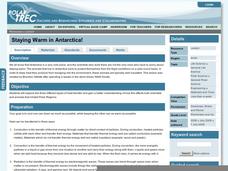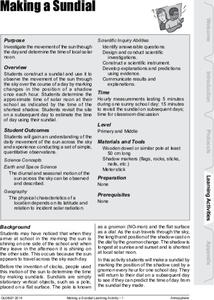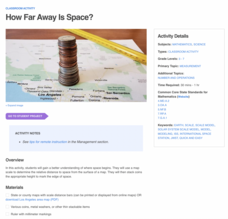California Academy of Science
Global Climate Change and Sea Level Rise
Ice is nice, and its condition on the planet has a significant effect. Junior geoscientists experiment with ice melting in both water and on land to discover how each affect the rising sea level. This detailed lesson plan outline even...
Polar Trec
Staying Warm in Antarctica!
Has your class ever wondered how animals and scientists stay warm in the Polar Regions? Kids will investigate to understand the three types of heat transfer and how heat transfer affects those trying to stay toasty in sub-zero...
Berkeley Engineering and Mentors
Egg Drop
How do different shapes affect the outcome associated with hard impact? All you need is an egg and some recycled materials to find out. Kids experiment to understand how airbags work to lessen the impact of two different types of...
Japan Society
A Remade Environment
Art is a wonderful way to express feelings of social unrest or change. Learners will examine the works of two contemporary Japanese artists, and how they each have used art to say something big. They analyze the work of Katsuhiro Saiki...
GLOBE Program
Making a Sundial
Sundials are more than just primitive clocks. Learners build their own sundials to study the location of the sun across the sky throughout the day. They use shadow evidence related to their sundials to make conclusions about solar movement.
NASA
Feel the Noise
Can you hear it now? Young scientists experiment with sound waves using metal objects and string. They strike metal objects while they hold them and as the objects hang from a string to compare the sound. They discover that sound travels...
Bonneville
Solar Powered Water Pumping
Here's the perfect lesson for those who think the world needs faster pumps. Building on the previous activity, scholars work to make the pumps function faster in transferring water between containers. They try adding an additional solar...
NASA
How Far Away Is Space?
Space is about 60 miles from the surface of Earth. Pupils make calculations to model that distance by stacking coins the appropriate height using scale. They then explore the distance to objects in space such as satellites and the space...
NASA
Mineral Mystery Experiment
One way to study something is to try to replicate it. Young scientists do just that as they use solutions to recreate mineral structures on a dwarf planet. They make solutions with different types of salt, evaporate them, and observe the...
NASA
Make a Planetary Exploration Balloon
Balloons aren't just for parties! An inquiry-based lesson explores the idea of using balloons for space exploration. Learners become engineers as they attempt to control the ascent and descent of a helium balloon using different masses.
Smithsonian Institution
Weather Widget
What's so difficult about predicting the weather? Scholars work collaboratively to build a device that models how meteorologists use computers to forecast weather. Team members collect and interpret data while working together to...
American Chemical Society
Heat Up and Cool Down
Don't be so dense! Using food coloring, pupils conduct two experiments with the difference in densities of hot and cold water. In the first experiment, learners add dyed hot and cold water into room temperature water and observe how the...
American Chemical Society
The Fate of Calcium Carbonate
Soften up an egg. Learners use vinegar to test for calcium carbonate in an egg shell and an antacid tablet and compare the reaction with vinegar to the reaction with water. In a second experiment, class members break down an egg shell...
American Chemical Society
Chromatography - Color Clues
Here's an activity that will change how one sees color. Pupils try out an experiment on chromatography where they place a drop of food coloring on a coffee filter, add several drops of water, and watch the colors spread and separate....
American Chemical Society
Chemistry Color Changers
Knowledge of acids and bases doesn't need to be a secret. Learners use red cabbage to create an indicator solution, then test how adding lemon juice (acid) and detergent (base) changes the color of the solution. They then use the concept...
American Chemical Society
Chemistry and Comics
Copying the comics couldn't be easier. A fun and simple activity has young scientists rub the back of a comic strip with a spoon to see if the ink will transfer to a white sheet of paper. They then repeat the experiment, rubbing...
American Chemical Society
Aware of the Air
It's there, even though no one can see it. Scholars create two different-sized parachutes out of shopping bags, then let them fall through the air. They should see that the larger parachute falls more slowly and interpret this to mean...
American Chemical Society
All Wet
Sometimes liquids just don't get along together. A fun experiment has scholars determine whether various liquids dissolve in water. They pour isopropyl alcohol, vegetable oil, and corn syrup into cups of water to see which ones mix well...
American Chemical Society
Heat - Energy on the Move
Turn up the heat. Individuals conduct two experiments to observe the difference between heated water and air versus cold water and air. Using food coloring, pupils observe the movement of the molecules in the two temperatures of water. A...
American Chemical Society
Great Electron Ripoff
Create a charge in the classroom. Using pieces of cellophane tape, a plastic grocery bag, and a balloon, learners investigate the effects of static electricity. Pupils create different charges in the materials and observe whether they...
American Chemical Society
Gas Sudsation
Bring out some bubbly! Individuals perform the classic baking soda and vinegar experiment with a twist. Learners add a drop of dish detergent to make the bubbles last longer. They vary the amount of baking soda and vinegar in an effort...
American Chemical Society
Fizz Bizz
Bubbles seem to come from nowhere. Pupils investigate the formation of carbon dioxide bubbles in sodas. By placing different objects, including candies, in the soda, learners observe the formation of tiny bubbles on the surface of the...
American Chemical Society
Condensation Station
Where does the water come from? Pupils conduct an experiment to learn more about condensation. Scholars fill two cups with ice water and isolate one from the surrounding air. They then use a coffee filter to compare the amount of water...
American Chemical Society
Evaporation Sensation
Where did the water go? Learners conduct an experiment to see how the difference in temperature affects evaporation rates. Scholars continue to investigate evaporation by comparing water and alcohol evaporation rates. Pupils experiment...

























